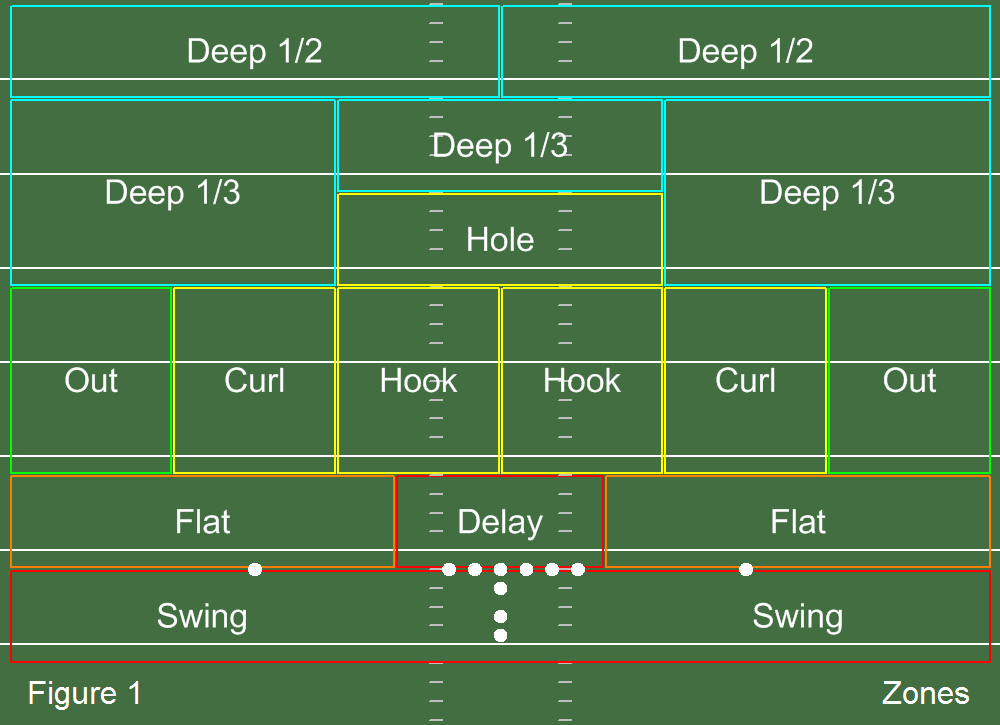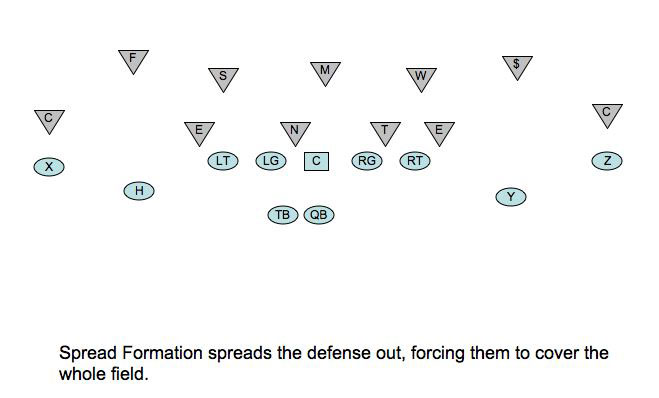Solid and Versatile
What It Is
The 4-3 defense, as the name may suggest, is a defensive scheme in which there are 4 defensive linemen backed up by three linebackers. This also means that the defense is putting 7 defensemen in the tackle box. It is also my favorite defense to run as it offers the most coverage/blitzing combinations as everything can be packaged into a triangle.
A large part of the 4-3 front is making sure your players are aligned properly and all are responsible for a gap. Look at this diagram for references.
That is called a technique numbering scheme. It is a way to describe how a defensive lineman or linebacker should be aligned. Let's look back at the diagram at the beginning of this post. The DT's are both aligned on the inside shoulders of the offensive guards. This would make them 1-technique players. The Defensive Ends are aligned on the outside shoulders of the offensive tackles. This would make them 6-technique players.
When describing techniques for linebackers, we just look at where they are lined up in reference to an offensive lineman, and add 0 to the end of their technique number. So in the diagram at the beginning, the middle linebacker is head up on the center, at linebacker depth (4-6 yards deep). This technique is referred to as a 00-technique, or a double-zero technique. The other two linebackers are on the inside shoulders of the offensive tackles, making them 40-technique players.
After taking care of our DL and LB's, we still have DB's to look at. Since there are 4 people left, we have 2 corners and 2 safeties. Safeties generally align 1-2 yards inside or outside the last man on the line of scrimmage at about 8 yards deep, depending on what the defense is game planning for that week. Corners will align differently depending on the coverage they're playing, but are usually either pressed up about 1 or two yards away from a WR, or 4-5 yards back from the WR.
Lastly, to summarize, here is a list of how players are commonly labeled in the 4-3 defense.
- E (Defensive End)
- T/3 (Defensive Tackle or 3-tech. These are generally interchangeable because most 4-3 defenses feature a specialized 3-technique player)
- N (Nose Guard)
- E (Other Defensive End)
- S ("Sam" Backer- Aligns to the strength of the offense)
- M ("Mike" Backer- Aligns generally in the middle uncovered gap of the offensive line)
- W ("Will" Backer - Aligns away from the strength of the offense)
- C (CornerBack)
- C (Other CornerBack)
- $ (Strong Safety- $ is used to avoid confusing him with the Sam because they are both on the same side of the field)
- F (Free Safety)
What it Does
The 4-3 defense is an extremely basic and coach-friendly defense to teach, due mostly to its balanced nature and utilization of the triangle concept, i.e. blitzes, stunts, and coverage adjustments can all be made in a way that it affects the triangle a player is part of. Look at the diagram below.
Now, as we can see, everybody is part of a triangle. What each yellow line signifies is a potential responsibility a player may have to another. For example: If the LB to the right were to blitz off the edge of the line of scrimmage, to the right of the DE, his assignment will affect the behavior or the Right DE, the Right DT, and potentially the CB and S he is attached to. Why? Because that LB blitzing just left a gap in the middle of the field where he came from. We don't want to get our other LB's out of their triangles because it disrupts the logic of the defense, so a Corner or Safety, or even the right DE would have to in some way make up for the LB blitzing. This could either be in the form of a man coverage assignment or a zone coverage assignment. As you'll see in a few, there are many options we have here.
What is Run
While we're on the topic of coverages, I may as well go over what can be run out of this defense. Since this is my first defensive posting, I want to cover the absolute basics the first time out.
- Zone Coverages
- Players are are responsible for defending an area of the field in the event of a pass. They must first read an offensive lineman to see if he is pass or run blocking. If he sets for pass, the defensive player must read the routes being run in front of him and determine who is most likely to threaten his zone. Once he does this, he must read the QB's body language to determine where the ball is going to be headed. Every zone a defensive player can drop to is in the picture below. If a defensive player is responsible for playing two zones, their names are joined by a hyphen, i.e. curl-flat, curl-out, hook-curl, etc.
- The simplest coverage to run out of the 4-3 is a Cover 4 defense. This is a defense in which the cornerbacks and safeties drop back and divide the deep field into four distinct zones, hence the name Cover 4.
- The linebackers divide the middle level of the field field into thirds, with the Sam and Will taking curl-out responsibilities, and the Mike taking either the double hook or Hole zones. This is known as 4 deep, 3 under.
- Alternatively, the defense can choose to drop one of their defensive ends off and make him play as a linebacker. This allows one more defender to defend the middle level of the field, at the expense of one defensive lineman rushing the quarterback. So, in this case, with 4 defensive backs dropping back deep, and 4 defenders defending the middle level of the field, that is known as a 4-deep, 4 under look.
- Another simple coverage to run out of the 4-3 is a Cover 2, Man Under look, otherwise known as 2 Man Under. The safeties drop back and divide the deep field into halves. Underneath those safeties, the Corners and LBS are in Man coverage. The Corners are assigned to the #1 receiver (the first eligible receiver from the sideline) on their side. The Sam and Will Linebackers are assigned to the # 2 receiver, if applicable. This leaves one person left to be covered, usually a running back in the backfield- this player is considered #3, if applicable, and covered by the Mike backer.
- This coverage ensures maximum protection against the pass by matching up one defensive player to one eligible receiver, as well as having two safeties free to assist on any routes that go deep.
- Man Coverage
- 2 Man- Under
- Man Free
- Instead of having a linebacker cover an eligible reciever, a safety switches jobs with a backer and takes over his priority. The backer, who now no longer has a coverage, can be used to spy the QB (do nothing else besides make sure he cannot escape the pocket untouched) or play a zone coverage on the middle level of the field. The safety left over that hasn't taken over a LB's job plays Cover 1- meaning he reads the field and the QB's eyes and helps with any deep route he thinks the QB is going to throw to.
- Cover 0
- Usually only used in conjuction with a 6-man blitz. There is no extra security downfield and if a receiver beats their man downfield, it's up to the QB to place the ball in the right spot to hit the receiver on the run.
- Blitzes
- Zone/Man Blitzes
- A zone blitz is when a defender blitzes the ball and the remaining defenders play a zone defense scheme. The defense can either opt to leave the area where the blitz man came from uncovered, or they can adjust their zone scheme to have some other defenders take responsibility for part of the uncovered zone. Either way, this opens up vulnerabilities in defensive pass coverage.
- A man blitz is when all defenders are manned up against a receiver and any defenders that aren't are rushing the QB.
- Why the 4-3 is perfect for blitzing
- The triangle concept between linebackers and linemen make blitzes easy to create, name, and understand.
- If the Sam or Will is blitzing, the T and E on his side will generally have a movement that frees up a gap for him to blitz in.
- If the Mike is blitzing, the T and T will generally have a movement that frees up a gap for him to blitz in.
- Sending 5 men still allows you to play solid zones underneath and above.
- Defensive ends ideally are generally guys who just missed the cut for the outside linebacker spot. They should be almost just as capable of dropping into coverage as the Sam and Will are.
- T's and E's can perform twists (deceptive moves in which the two switch places by one of them slanting [taking a hard 45 degree step into the line of scrimmage] and looping [taking one jab step upfield and then almost pulling like an offensive lineman around the slant, then continuing his rush upfield]) by themselves without requiring a coach's instruction to do so, if it is desired.
- Because your defense is balanced on every level, you can easily rotate one defender to another defender's spot to make up for a gap created by a blitz.
Who Runs It
Every level, from peewees to pros. The concepts involved in the 4-3 can be as simple or as complicated as the coach is willing and able to make them, and teaching them isn't difficult.
Why it's so Great to Have in Your Repertoire
If the above details haven't convinced you of this already, let me summarize it for you:
- A true 5-man front (5 DL) is too linemen-heavy and sacrifices too much in the event of a pass.
- The 3-4 requires more adjustment from and communication between linebackers and DB's during the pre-snap, and if you're going to blitz somebody out of the 3-4, you pretty much just turned into a 4-3 but with one non-specialized lineman rushing.
- The 4-3 allows you to, in theory, have your linemen be responsible for playing two gaps, allowing them to play a more involved role in the game.
- The 4-3 allows your linebackers to react more confidently to the run if your linemen are halfway decent at doing their jobs.
- 4-3 blitzes allow for easier coverage pickups between your LB's and DB's due to the triangle concept, no matter where you are blitzing anyone from.
- You can play conservatively, normally, or aggressively out of the 4-3 without cluing the offense in too much before the ball is snapped.
Hope this helps!
Cheers,
J




